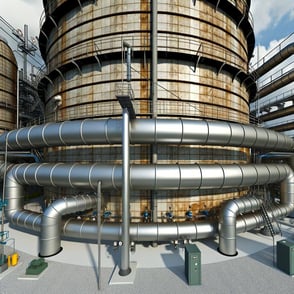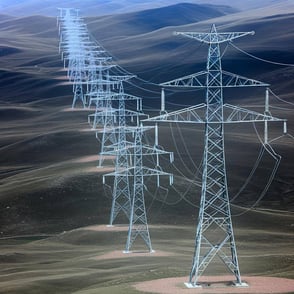Geothermal Energy Generation
Geothermal plants generate power by harnessing heat from the Earth's interior. They use steam or hot water from the ground to drive turbines, producing electricity with minimal emissions.
What is Geothermal Energy Generation?
Geothermal energy is a renewable energy source that harnesses the heat from the Earth's interior to generate electricity and provide heating. This heat originates from the radioactive decay of minerals and the original heat from the planet's formation. Geothermal energy is considered sustainable and environmentally friendly, as it produces minimal greenhouse gas emissions and provides a consistent energy supply, unlike solar or wind power, which are weather-dependent. Geothermal energy can be harnessed in various ways, depending on the geological characteristics of a region.
How Geothermal Energy Generation Works
Geothermal energy generation involves tapping into the Earth's internal heat through various technologies and methods. The primary components of a geothermal power plant include production wells, injection wells, a heat exchanger, and a turbine-generator system. Wells are drilled deep into the Earth to access hot water and steam reservoirs located in geothermal reservoirs. The depth and temperature of these reservoirs can vary, but they are typically found at depths ranging from a few hundred to several thousand meters. The hot water or steam extracted from the production wells is passed through a heat exchanger. In a direct steam plant, the steam is directly used to drive the turbine. In a binary cycle plant, the geothermal fluid heats a secondary fluid with a lower boiling point, causing it to vaporize and drive the turbine. The steam or vaporized secondary fluid drives the turbine, which is connected to a generator. As the turbine blades spin, they turn the generator, converting mechanical energy into electrical energy. After the geothermal fluid has passed through the heat exchanger, it is reinjected back into the Earth through injection wells. This process helps maintain reservoir pressure and ensures the sustainability of the geothermal resource.

There are three main types of geothermal power plants. The simplest and oldest type of geothermal power plant, dry steam plants use steam extracted directly from geothermal reservoirs to turn the turbine. These plants are located in regions with natural steam reservoirs. Flash steam power plants use high-pressure hot water from geothermal reservoirs. The water is depressurized, or "flashed," into steam, which drives the turbine. Flash steam plants are the most common type of geothermal power plant and are used in areas with high-temperature geothermal resources. Binary cycle power plants use moderate-temperature geothermal resources. The geothermal fluid heats a secondary fluid with a lower boiling point in a heat exchanger. The secondary fluid vaporizes and drives the turbine. Binary cycle plants can operate with lower temperature resources and have a closed-loop system, minimizing environmental impact.
The Impact of Geothermal Energy on the Energy Sector
Geothermal energy has a significant impact on the energy sector due to its reliability, sustainability, and low environmental impact. Geothermal energy is a renewable resource as it exploits the Earth's internal heat, which is virtually inexhaustible on a human timescale. The continuous heat flow from the Earth's core ensures a long-term supply of energy. Geothermal energy generation has a relatively low environmental footprint. It produces minimal greenhouse gas emissions compared to fossil fuels and has lower land-use impacts than large-scale solar or wind farms. Additionally, binary cycle plants have negligible emissions, as they do not release geothermal fluids into the atmosphere. Despite its advantages, geothermal energy generation faces several challenges. The initial cost of drilling and plant construction can be high, and the development process can be lengthy and complex due to geological assessments and the need for precise drilling. Geothermal resources are also location-specific, limiting their availability to regions with suitable geological conditions.
Conclusion
Geothermal energy generation is a reliable, sustainable, and environmentally friendly energy source with the potential to play a significant role in the global energy mix. By providing consistent and stable power, reducing greenhouse gas emissions, and supporting economic development, geothermal energy offers numerous benefits. As technology advances and exploration techniques improve, the utilization of geothermal energy is expected to expand, contributing to a more sustainable and resilient energy future.
Glossary
- Geothermal Reservoir: An underground area of porous rock containing hot water or steam used for geothermal energy production.
- Production Wells: Wells drilled into the geothermal reservoir to bring hot water or steam to the surface.
- Power Plant: A facility that converts geothermal thermal energy into electricity.
- Injection Wells: Wells used to return cooled water back into the geothermal reservoir.
- Dry Steam Power Plant: A type of geothermal power plant that directly uses steam from the geothermal reservoir to generate electricity.
- Flash Steam Power Plant: A geothermal power plant that uses high-pressure hot water that "flashes" into steam to drive turbines.
- Binary Cycle Power Plant: A geothermal power plant that uses a secondary fluid with a lower boiling point than water, heated by geothermal water, to drive turbines.
- Heat Exchanger: A device that transfers heat from the geothermal water to the secondary fluid in a binary cycle power plant.
- Renewable Energy: Energy generated from natural processes that are continuously replenished, such as geothermal heat, solar radiation, wind, and hydropower.
- Greenhouse Gas Emissions: Gases released into the atmosphere that trap heat and contribute to global warming, such as carbon dioxide and methane.
.png?width=200&height=80&name=etpa-logo-color%20(1).png)































.png)
.png)
-1.png?width=250&height=100&name=etpa-logo-color%20(1)-1.png)